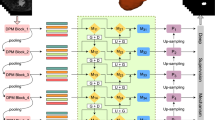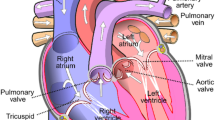Abstract
Segmenting left atrium in MR volume holds great potentials in promoting the treatment of atrial fibrillation. However, the varying anatomies, artifacts and low contrasts among tissues hinder the advance of both manual and automated solutions. In this paper, we propose a fully-automated framework to segment left atrium in gadolinium-enhanced MR volumes. The region of left atrium is firstly automatically localized by a detection module. Our framework then originates with a customized 3D deep neural network to fully explore the spatial dependency in the region for segmentation. To alleviate the risk of low training efficiency and potential overfitting, we enhance our deep network with the transfer learning and deep supervision strategy. Main contribution of our network design lies in the composite loss function to combat the boundary ambiguity and hard examples. We firstly adopt the Overlap loss to encourage network reduce the overlap between the foreground and background and thus sharpen the predictions on boundary. We then propose a novel Focal Positive loss to guide the learning of voxel-specific threshold and emphasize the foreground to improve classification sensitivity. Further improvement is obtained with an recursive training scheme. With ablation studies, all the introduced modules prove to be effective. The proposed framework achieves an average Dice of \(92.24\%\) in segmenting left atrium with pulmonary veins on 20 testing volumes.
X. Yang and N. Wang—Authors contribute equally to this work.
Access this chapter
Tax calculation will be finalised at checkout
Purchases are for personal use only
Similar content being viewed by others
References
Bai, W., Shi, W., Ledig, C., Rueckert, D.: Multi-atlas segmentation with augmented features for cardiac MR images. Med. Image Anal. 19(1), 98–109 (2015)
Chen, H., Ni, D., Qin, J., et al.: Standard plane localization in fetal ultrasound via domain transferred deep neural networks. IEEE JBHI 19(5), 1627–1636 (2015)
Chen, J., Yang, G., Gao, Z., et al.: Multiview two-task recursive attention model for left atrium and atrial scars segmentation. arXiv preprint arXiv:1806.04597 (2018)
Çiçek, Ö., Abdulkadir, A., et al.: 3d u-net: Learning dense volumetric segmentation from sparse annotation. arXiv preprint arXiv:1606.06650 (2016)
Dou, Q., Yu, L., et al.: 3D deeply supervised network for automated segmentation of volumetric medical images. Med. Image Anal. 41, 40–54 (2017)
McGann, C., Akoum, N., et al.: Atrial fibrillation ablation outcome is predicted by left atrial remodeling on MRI. Circ. Arrhythm. Electrophysiol. 7, 23–30 (2013)
Mortazi, A., Karim, R., Rhode, K., Burt, J., Bagci, U.: CardiacNET: segmentation of left atrium and proximal pulmonary veins from MRI using multi-view CNN. In: Descoteaux, M., Maier-Hein, L., Franz, A., Jannin, P., Collins, D.L., Duchesne, S. (eds.) MICCAI 2017, Part II. LNCS, vol. 10434, pp. 377–385. Springer, Cham (2017). https://doi.org/10.1007/978-3-319-66185-8_43
Peng, P., Lekadir, K., et al.: A review of heart chamber segmentation for structural and functional analysis using cardiac magnetic resonance imaging. Magn. Reson. Mater. Phys. Biol. Med. 29(2), 155–195 (2016)
Ren, S., He, K., Girshick, R., Sun, J.: Faster R-CNN: towards real-time object detection with region proposal networks. In: NIPS, pp. 91–99 (2015)
Tobon-Gomez, C., Geers, A.J., et al.: Benchmark for algorithms segmenting the left atrium from 3D CT and MRI datasets. IEEE TMI 34(7), 1460–1473 (2015)
Tran, D., Bourdev, L., Fergus, R., Torresani, L., Paluri, M.: Learning spatiotemporal features with 3D convolutional networks. In: ICCV, pp. 4489–4497 (2015)
Tu, Z., Bai, X.: Auto-context and its application to high-level vision tasks and 3D brain image segmentation. IEEE TPAMI 32(10), 1744–1757 (2010)
Wang, Z., et al.: Automated detection of clinically significant prostate cancer in mp-MRI images based on an end-to-end deep neural network. IEEE TMI 37, 1127–1139 (2018)
Yang, G., Zhuang, X., Khan, H., et al.: A fully automatic deep learning method for atrial scarring segmentation from late gadolinium-enhanced MRI images. In: ISBI 2017, pp. 844–848. IEEE (2017)
Yang, X., Bian, C., Yu, L., Ni, D., Heng, P.-A.: Hybrid loss guided convolutional networks for whole heart parsing. In: Pop, M., et al. (eds.) STACOM 2017. LNCS, vol. 10663, pp. 215–223. Springer, Cham (2018). https://doi.org/10.1007/978-3-319-75541-0_23
Zheng, Y., et al.: Multi-part modeling and segmentation of left atrium in C-arm CT for image-guided ablation of atrial fibrillation. IEEE TMI 33(2), 318–331 (2014)
Zhuang, X., et al.: A registration-based propagation framework for automatic whole heart segmentation of cardiac MRI. IEEE TMI 29(9), 1612–1625 (2010)
Acknowledgments
The work in this paper was supported by a grant from the Research Grants Council of the Hong Kong Special Administrative Region (Project no. GRF 14225616), a grant from National Natural Science Foundation of China under Grant 61571304, Grant 81771598, and Shenzhen Peacock Plan under Grant KQTD2016053112051497.
Author information
Authors and Affiliations
Corresponding author
Editor information
Editors and Affiliations
Rights and permissions
Copyright information
© 2019 Springer Nature Switzerland AG
About this paper
Cite this paper
Yang, X. et al. (2019). Combating Uncertainty with Novel Losses for Automatic Left Atrium Segmentation. In: Pop, M., et al. Statistical Atlases and Computational Models of the Heart. Atrial Segmentation and LV Quantification Challenges. STACOM 2018. Lecture Notes in Computer Science(), vol 11395. Springer, Cham. https://doi.org/10.1007/978-3-030-12029-0_27
Download citation
DOI: https://doi.org/10.1007/978-3-030-12029-0_27
Published:
Publisher Name: Springer, Cham
Print ISBN: 978-3-030-12028-3
Online ISBN: 978-3-030-12029-0
eBook Packages: Computer ScienceComputer Science (R0)




